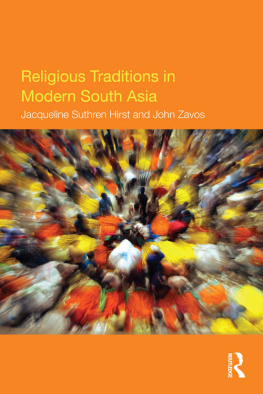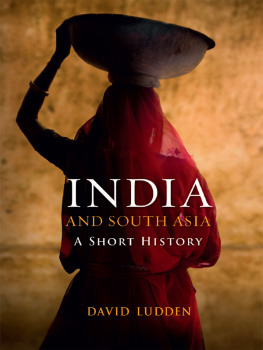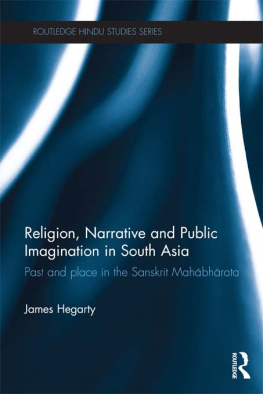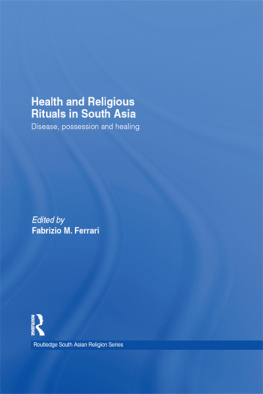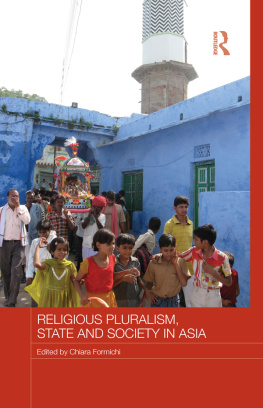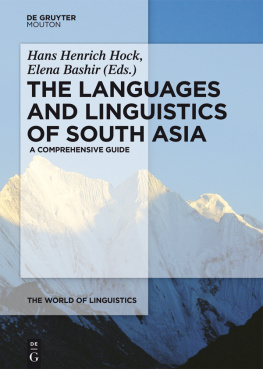Suthren Hirst - Religious Traditions in Modern South Asia
Here you can read online Suthren Hirst - Religious Traditions in Modern South Asia full text of the book (entire story) in english for free. Download pdf and epub, get meaning, cover and reviews about this ebook. City: London;South Asia, year: 2011, publisher: Taylor & Francis (CAM);Routledge, genre: Religion. Description of the work, (preface) as well as reviews are available. Best literature library LitArk.com created for fans of good reading and offers a wide selection of genres:
Romance novel
Science fiction
Adventure
Detective
Science
History
Home and family
Prose
Art
Politics
Computer
Non-fiction
Religion
Business
Children
Humor
Choose a favorite category and find really read worthwhile books. Enjoy immersion in the world of imagination, feel the emotions of the characters or learn something new for yourself, make an fascinating discovery.
- Book:Religious Traditions in Modern South Asia
- Author:
- Publisher:Taylor & Francis (CAM);Routledge
- Genre:
- Year:2011
- City:London;South Asia
- Rating:3 / 5
- Favourites:Add to favourites
- Your mark:
- 60
- 1
- 2
- 3
- 4
- 5
Religious Traditions in Modern South Asia: summary, description and annotation
We offer to read an annotation, description, summary or preface (depends on what the author of the book "Religious Traditions in Modern South Asia" wrote himself). If you haven't found the necessary information about the book — write in the comments, we will try to find it.
Religious Traditions in Modern South Asia — read online for free the complete book (whole text) full work
Below is the text of the book, divided by pages. System saving the place of the last page read, allows you to conveniently read the book "Religious Traditions in Modern South Asia" online for free, without having to search again every time where you left off. Put a bookmark, and you can go to the page where you finished reading at any time.
Font size:
Interval:
Bookmark:
Religious Traditions in Modern South Asia
This book offers a fresh approach to the study of religion in modern South Asia. It uses a series of case studies to explore the development of religious ideas and practices, giving students an understanding of the social, political and historical context. It looks at some familiar themes in the study of religion, such as deity, authoritative texts, myth, worship, teacher traditions and caste, and some of the key ways in which Buddhism, Hinduism, Islam and Sikhism in South Asia have been shaped in the modern period. The book points to the diversity of ways of looking at religious traditions and considers the impact of gender and politics, and the way religion itself is variously understood.
Jacqueline Suthren Hirst is Senior Lecturer in South Asian Studies at the University of Manchester, UK. Her publications include Sitas Story and amkaras Advaita Vednta: A Way of Teaching.
John Zavos is Senior Lecturer in South Asian Studies at the University of Manchester, UK. He is the author of The Emergence of Hindu Nationalism in India.
Religious Traditions in Modern South Asia
Jacqueline Suthren Hirst and John Zavos

First published 2011
by Routledge
2 Park Square, Milton Park, Abingdon, Oxon OX14 4RN
Simultaneously published in the USA and Canada
by Routledge
711 Third Avenue, New York, NY 10017
Routledge is an imprint of the Taylor & Francis Group, an informa business
2011 Jacqueline Suthren Hirst and John Zavos
The right of Jacqueline Suthren Hirst and John Zavos to be identified as authors of this work has been asserted by them in accordance with sections 77 and 78 of the Copyright, Designs and Patents Act 1988.
All rights reserved. No part of this book may be reprinted or reproduced or utilised in any form or by any electronic, mechanical, or other means, now known or hereafter invented, including photocopying and recording, or in any information storage or retrieval system, without permission in writing from the publishers.
Trademark notice: Product or corporate names may be trademarks or registered trademarks, and are used only for identification and explanation without intent to infringe.
British Library Cataloguing in Publication Data
A catalogue record for this book is available from the British Library
Library of Congress Cataloging in Publication Data
A catalog record for this book has been requested
ISBN: 9780415447874 (hbk)
ISBN: 9780415447881 (pbk)
ISBN: 9780203802427 (ebk)
Figures
Boxes
Preface
This book began life in a series of conversations amongst colleagues at the University of Manchester in the early and mid-2000s. At that time, we were fortunate to have the input of a range of scholars whose research work focused on religious traditions in South Asia. Along with ourselves, Roger Ballard, Jeanne Openshaw, Mary Searle-Chatterjee, Alan Williams and, later, Nile Green and Atreyee Sen were all engaged in research work that explored elements of the dynamic, developing histories and contemporary practices associated with these traditions. As we have all at various times been part of the Department of Religions and Theology (with colleagues in South Asian Studies in other departments across the university), we have all also been engaged in teaching about these traditions, confronting the challenges thrown up by the postcolonial twins that are South Asian Studies and Religious Studies. Our book is an attempt to come to terms with these challenges, bringing together our own research interests and our joint interest in opening up new ways of teaching and learning about the field of study that we love.
Being able to identify these two postcolonial twins is very much the result of stimulating research work in these two areas of study over the past thirty years or so. Both South Asia and Religion have been subjected to some rigorous and vigorous critique by scholars such as Dipesh Chakrabarty, Sudipto Kaviraj, Gayatri Spivak, Peter van der Veer, Richard King and Timothy Fitzgerald. In particular, such scholars as these have challenged established structures of knowledge, by considering how the encounters and entanglements of colonialism have contributed to the development of modern social and political relations, and modern cultural practices. In the light of such work, research on religious traditions in and of South Asia has taken a critical and reflexive turn, exploring the categories through which we understand everyday life in an attempt to get closer to understandings of just how such life has been and is experienced.
This is challenging enough in a research context. In a teaching context, we have found that the challenge is often amplified. This is partly because many students in our experience have entered university with quite fixed ideas of what religion is. Within this framework, they then have further fixed ideas about what South Asian religion should constitute. Often, these ideas Teaching and learning about South Asian religious traditions in particular demands this multiplex approach, because it enables us to de-centre [or, to borrow a term from Chakrabarty (2000), provincialize] the World Religions model, to explore the possibility of other ways of experiencing and understanding the world, and to unpack the relations of power through which dominant ways of looking are established.
In addressing these issues, we have often been struck by the way in which texts designed for students seem to re-instantiate these relations of power, by presenting the religions of South Asia as discrete, self-evident forms. Many of the texts we have used in a teaching context do this implicitly by presenting students with an introduction to Hinduism, Sikhism and so on. Even those that seek to encompass a broader range of traditions often present these traditions separately in different chapters. A recent work edited by the US-based scholars Sushil Mittal and Gene Thursby (2006) takes this approach, presenting nine well-informed chapters that deal with Hinduism, Jainism, Buddhism, Sikhism, Zoroastrianism, Judaism, Christianity, Islam and Bahai in turn. In their introduction, Mittal and Thursby do acknowledge theoretical work that interrogates such categories, and have included a concluding chapter that addresses these issues. At the same time, they argue that the introductory nature of the book means that such issues should be dealt with after students have been acquainted with good to think with prototypes or first models of traditions, unburdened by on-going problems and alternative perspectives that are debated at scholarly conferences and in academic journals (Mittal and Thursby 2006: 9). Our approach is different. We believe that it is important for students to engage with these problems and perspectives in the first instance, in order to encourage them to develop a critical approach to their material. Engendering a critical approach, in which the idea of religion is approached contextually, will help students to come to their material without presuppositions about what Hinduism, Sikhism, Islam and so on are.
Our approach has been developed through close discussion with colleagues at Manchester and at two international seminars in 2001 and 2003 focused on teaching across South Asian religious traditions. This work then led us to guest edit a special issue of the journal Contemporary South Asia on this topic in 2005 (Volume 14, Number 1), showcasing a range of articles with different ways of approaching the diverse religious traditions of the region. Since then we have engaged in research and teaching projects that have helped us to develop our ideas further. In particular, the broader Religions and Theology research cluster at Manchester held a series of internal seminars in 2004 and 2005 that looked to interrogate the category of religion across the diverse range of our collective research interests. This project led to a collective publication (Green and Searle-Chatterjee 2008) in which both of us published essays that extended our thinking about alternative ways of looking at our field. As you can see, then, the ideas that inform this book have been germinating for some time, and we are very grateful to all our colleagues at Manchester for their encouragement, and for helping to engender a stimulating environment in which research and teaching are persistently held to be in dialogue.
Next pageFont size:
Interval:
Bookmark:
Similar books «Religious Traditions in Modern South Asia»
Look at similar books to Religious Traditions in Modern South Asia. We have selected literature similar in name and meaning in the hope of providing readers with more options to find new, interesting, not yet read works.
Discussion, reviews of the book Religious Traditions in Modern South Asia and just readers' own opinions. Leave your comments, write what you think about the work, its meaning or the main characters. Specify what exactly you liked and what you didn't like, and why you think so.

